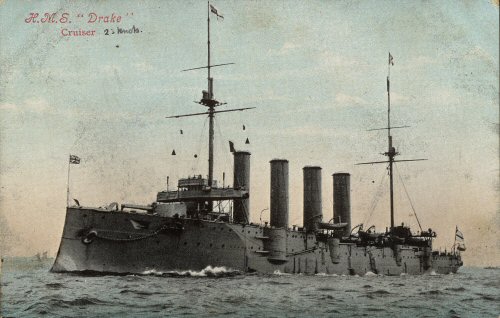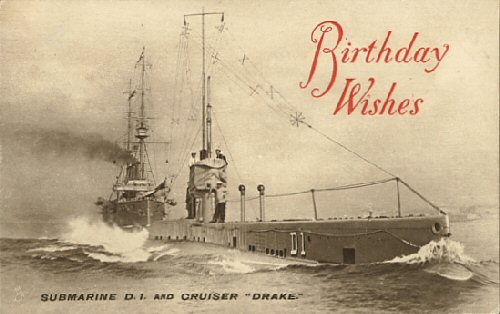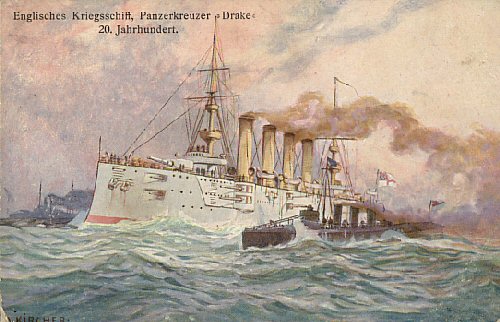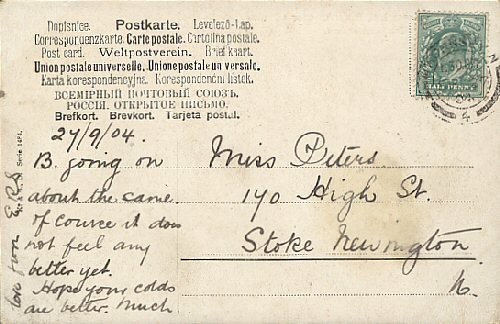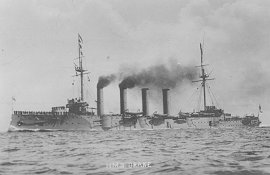
Torpedoed and sunk 2 October 1917
H.M.S.Drake was built in 1901, a 'Drake' class armoured cruiser, at 23 knots was one of the fastest cruisers in the world at that time, her armaments included two primary 9.2 inch centre line turrets, sixteen secondary 6 inch single barbettes, twelve auxiliary twelve pounders, three auxiliary three pounders and two eighteen inch submerged torpedo tubes. Other ships in her class were the Good Hope, King Alfred and Leviathan. She became the flagship of Rear Admiral Battenburg in 1905 and her stations included the Mediterranean Grand Fleet from 1914-15 and the North American and West Indies theatre of operations from 1915-17. In August, 1914 shortly after the declaration of war, she escorted the Belfast built 'Olympic' (sister ship of the Titanic) into Liverpool. the Olympic had sailed empty from New York - H.M.S. Essex escorted her for part of the crossing and she was met by the Drake in the Northern Approaches and escorted to port.
On the morning of October 2nd 1917, HMS Drake was several miles off the north-west tip of Rathlin Island, carrying out routine escort duties with convoy HH24 inbound from America. The area was frequented by German U boats who were engaged in both mine laying and convoy attacks in the Western and Northern Approaches - as part of an overall German strategy to blockade convoy supplies reaching the United Kingdom. U79, a mine laying submarine was on active duty around the north west of Ireland and the western Scottish Isles at the time.
The U-Boat located HH24 in the early morning, found the Drake in her sight and fired one of her compliment of four torpedoes, the resulting explosion killed 19 seamen though the cruiser remained afloat. After the attack and as normal procedure, the convoy dispersed - the remaining naval and auxiliary escorts including the H.M.S. Brisk, a type H (Acorn) destroyer, were deployed to follow up on the dispersed ships, some through Rathlin Sound and others in the North Channel. The 2,372 ton S.S. Lugano, loaded with cotton and steel from Virginia came into the Sound and was hit on her starboard side by one torpedo fired from U79, the explosion ripped a large hole in the hull resulting in her sinking rapidly, though with no loss of life. Shortly afterwards HMS Brisk following up on her charges made a sweep up the Sound and was hit by one torpedo amidships causing a catastrophic explosion which broke her in two, the bow section sank in the Sound and the stern section was eventually towed into Londonderry - the explosion killed thirty-one seamen. Both the Brisk and Lugano lie within 3km of each other - although there is no evidence to say that U79 torpedoed HMS Brisk, the close proximity of the two attacks would suggest that she may have lay in wait and done so. If so it would have been a major achievement for an U-Boat Captain to claim a Cruiser, Destroyer and a 2,350ton Merchant ship within a few hours of each.
The crippled Drake under the command of Captain S. H. Radcliffe was escorted into Church Bay by H.M.S. Martin and other auxiliary ships where she was anchored. There were suggestions that to save her an attempt was going to be made to beach her in Church Bay, unfortunately the degree of list became critical and she was abandoned to capsize in eighteen metres of water a few hundred metres from the shore. There were no casualties as a result of the capsizing and the Admiralty announced her loss on October 4th, though no reference was made to HMS Brisk.
The Drake did not lie undisturbed for on the 4th November 1962, the 595 ton 'Ella Hewitt' skippered by William Gregson fouled the wreck while leaving Church Bay and within eighteen hours had sunk adjacent to her. Owned by the Hewitt Fishing Company of Fleetwood, the 'Ella Hewitt' was built in 1953 and at 170ft was one of largest trawlers operating out of Fleetwood at that time. Many stories surround the circumstances of the sinking of the 'Ella Hewitt', the facts are she hit the wreck and sank.
